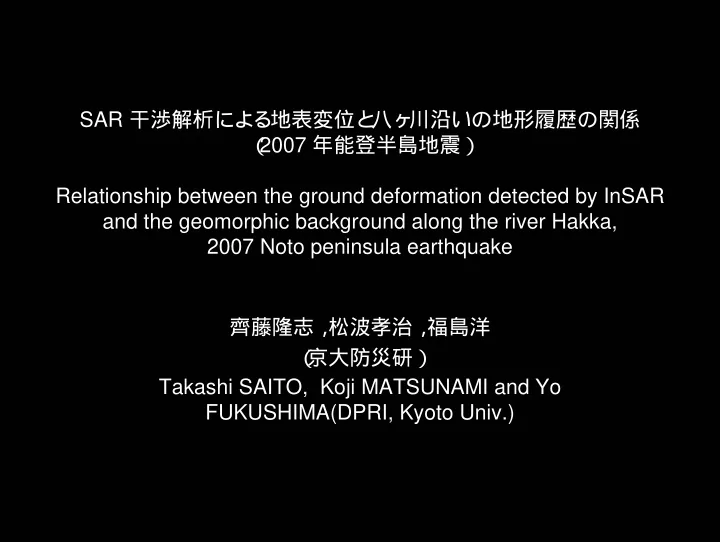

SAR 干渉解析による地表変位と 八ヶ 川沿いの地形履歴の関係 ( 2007 年能登半島地震) Relationship between the ground deformation detected by InSAR and the geomorphic background along the river Hakka, 2007 Noto peninsula earthquake 齊藤隆志, 松波孝治, 福島洋 ( 京大防災研) Takashi SAITO, Koji MATSUNAMI and Yo FUKUSHIMA(DPRI, Kyoto Univ.)
Objectives • Prediction of the locations where reactivated landslides, slope failures, and ground subsidence will occur triggered by the strong ground motion as well as intense rainfalls. • Establish the monitoring methods of landslide activity. • Case study to achieve the prediction methods. by InSAR.
Displacements detected by InSAR • Displacements by InSAR = Contributions of Crustal Movement and Local Geomorphic Changes triggered by the strong ground motion(ground subsidence, landslide, and slope failure) + Errors Local Geomorphic changes by Eq. occur by affecting several conditions (hydrologic, geomorphic, geologic, and 3D material structure) as well as amplitudes and frequencies of the seismic wave. (specially in case liquefaction concerned)
Surficial displacement by the InSAR analysis (Fukushima et al.,2007) originally shown in fringe Satellite Daichi, PALSAR Feb. 23, 2007- Epicenter Apr. 10, 2007 Ascending Incident angle 47 degree Azimuth direction Landslide? (N80 ° E) Ground range
The contour lines of the surficial displacement by InSAR (ascending) contour interval is 5 centimeter The contour lines near the epicenter are clear, showing the crustal movements strongly Epicenter -45cm The contour lines far from the epicenter are not clear, since the -30cm contributions of local geomorphic Azimuth direction changes become greater than those (N80 ° E) of the crustal movement among the total displacement Ground range
The relationship between surficial geological settings and the displacements The relationship between surficial geological settings and the surficial displacements There seems to be less agreement between surficial geology and surficial displacements of InSAR r There seems to be less match But in the distant area from epicenter, the spread isolines of a s between surficial geology and show the agreements with the patterns of river system, displacements of InSAR results especially with the distributions of alluvial plains But in the distant area from epicenter, the spread isolines of a surficial displacement show good match with the patterns of river system, especially with the distributions of alluvial plains
The contour of surficial displacements and river system The grids (contributing area is greater than 50 grids and altitutde is less than 100m) are shown in gray.
The topographic map and displacements by InSAR (ascending) Kuroshima Touge and Monzen had suffered the largest damages to residential houses The bluish area: in movements of uplift or toward western direction The reddish area: in movements of subsidence or toward eastern direction
Methods • GIS (Basically overly following information) • Displacements by InSAR • Topographic map • Geological map • Landslides distribution map • Hydrogeomorphic analysis by 10mDEM (slope inclination, upstream area) • Aerial photographs (stereo photo interpretation, repeat photography to detect the artificial land use change) • Ground truth (recognition of surficial geomorphic change)
Topographic map + InSAR
The ground subsidence at Monzen Bosai Center
Ground subsidence near Hokkoku Bank: Hashiride
Landslide in Ohkubo 周辺部が東向き ・ 沈降だが部分的に西向き ・ 隆起 西方向 西方向 水の湧出
Slope failures at Asouda 1 2 1 2 上部 2 下部
Topographic map (Touge)
InSAR (ascending)
Topographic map + InSAR
Orthophoto 2007 after Eq.
Orthophoto 1947
Orthophoto 2007 after Eq. + InSAR
Orthophotos 1947 and 2007
Orthophoto 1947 + InSAR
Orthophoto 1947 + fan margin
InSAR + fan margin
Orthophoto 2007 + fan margin
Topographic map (Monzen)
InSAR (ascending)
Topographic map + InSAR
The ground subsidence at Monzen Bosai Center
Topographic map + InSAR + Landslides
Orthophoto 2007 after Eq.
Orthophoto 1947
Orthophoto 2007 after Eq. + InSAR
Orthophotos 1947 and 2007
Orthophoto 1947 + InSAR
Orthophoto 1947 + fan margin
InSAR + fan margin + landslides
Orthophoto 2007 + InSAR + fan margin
Topograghic map + InSAR (Kuroshima)
Orthophoto 1947 + InSAR
Orthophoto 1947 + InSAR + Landslides
Summary • The deformation by InSAR analysis recognized as the ground subsidence in situ are coincide with the locations of old river channels, the marginal areas of sub- streams’ fans and (artificial) embankments. • In landslide areas, the directions of ground deformations detected by InSAR are also coincide with the downward of the slopes. (displacements of some landslides are not recognized in situ) • InSAR would be possibly the powerful tool for detecting the local ground surface deformation as well as the crustal movements caused by the earthquakes.
Recommend
More recommend